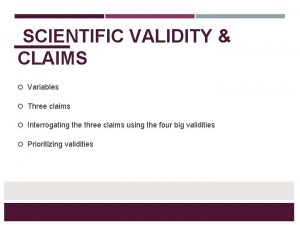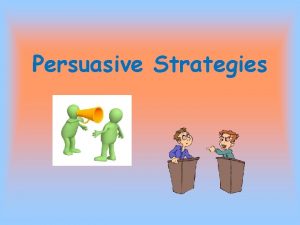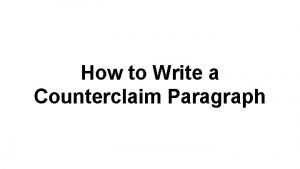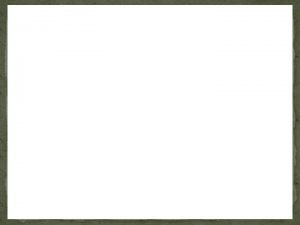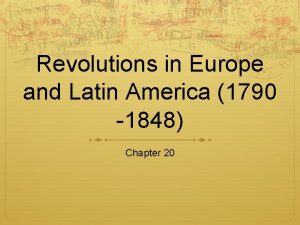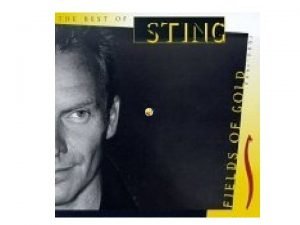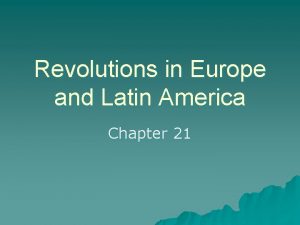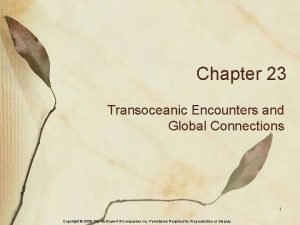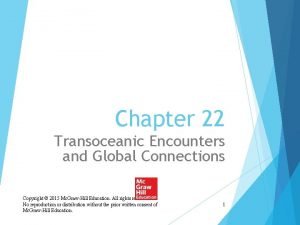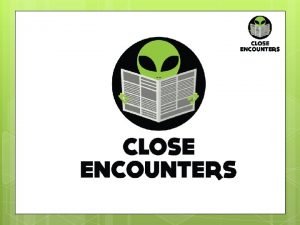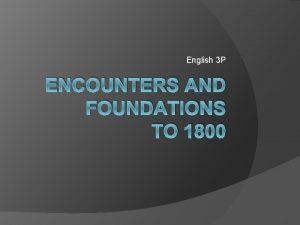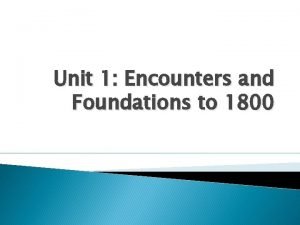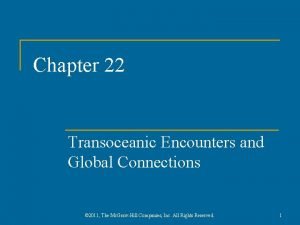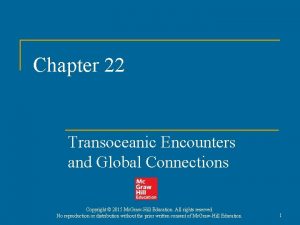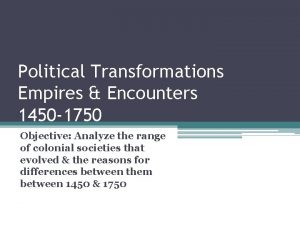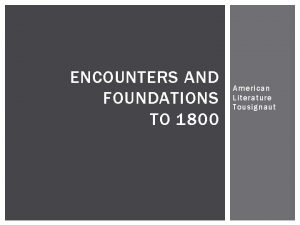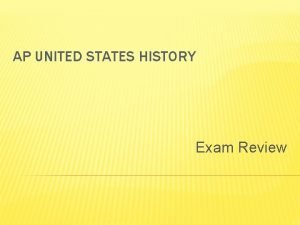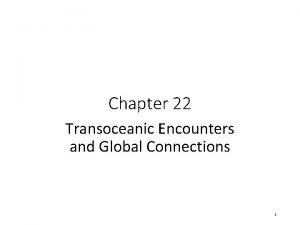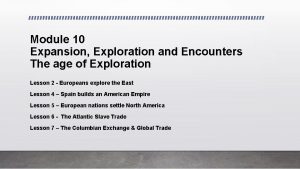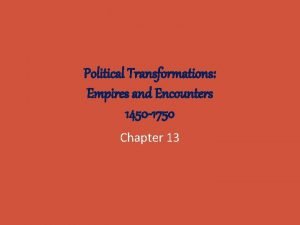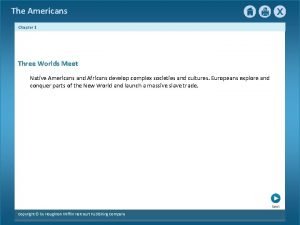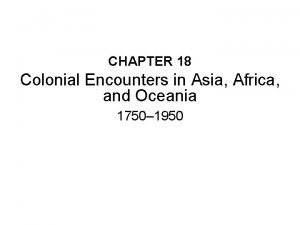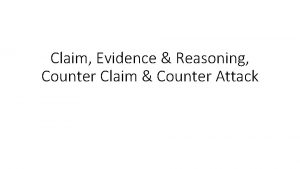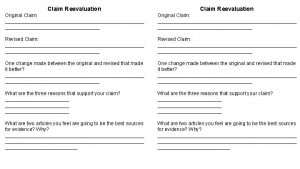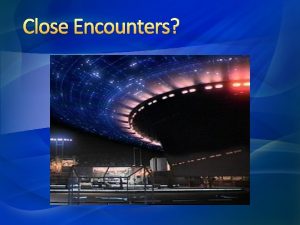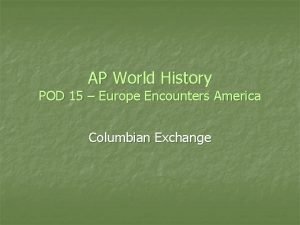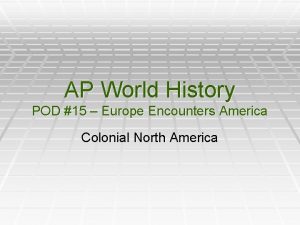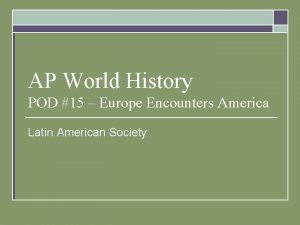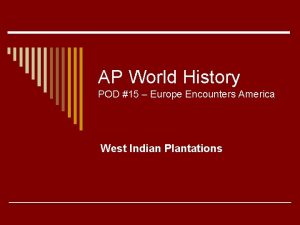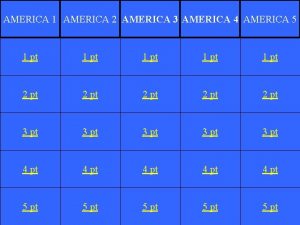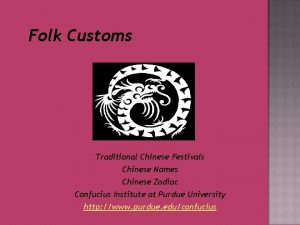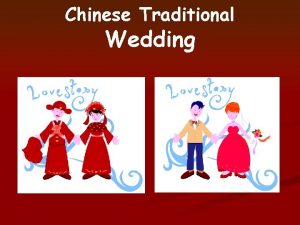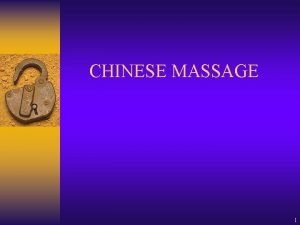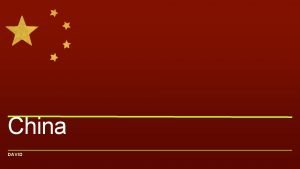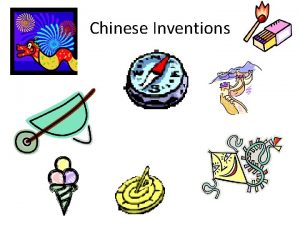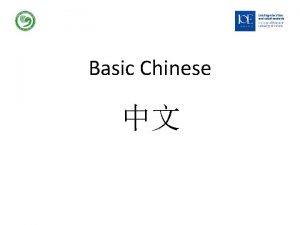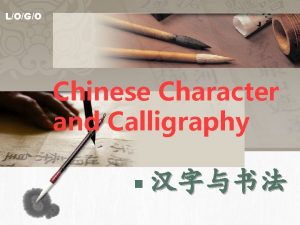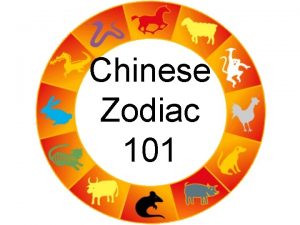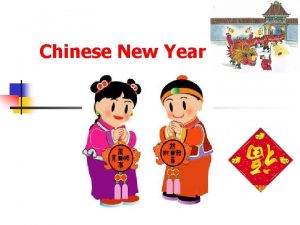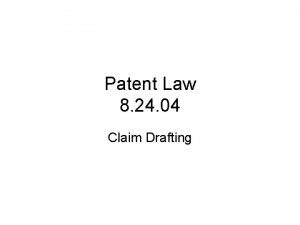Europe Encounters America The Chinese now claim to
















































- Slides: 48

Europe Encounters America

• The Chinese now claim to have discovered America about 50 years before Columbus (1421). Writings and maps from a Chinese explorer shows the Pacific coast and even has some pretty accurate Native American art. The question is – is this stuff real or created later?

The First Europeans in America were… • Vikings. Around the year 1000 A. D. Leif Erickson and 35 other Vikings explored the coast of Canada. • They tried to start a colony there was were driven out by the local natives.

Enter the Renaissance • By 1400, most educated Europeans knew that the world was round. They simply had not explored the oceans due to lack of big ships. • In 1406, an old map written by Claudius Ptolemy was discovered. The map was over 1200 years old. It established our lines of latitude and longitude for accurate sailing.

• Ptolemy’s Geography was published in 1475. • According to this map, Spain and China were only a few days sailing apart. • What do we now know is between them?

Christopher Columbus • Columbus, convinced that “the end of Spain and the beginning of India are not far apart” tried to convince the king of Portugal to finance a trip to find a new route to Asia. • The king referred him to a committee of map experts who said that his old maps were inaccurate.

• While Columbus and the committee debated, Bartolomeu Dias found a new route around Africa to Asia so Portugal no longer had any interest in Columbus.

• Columbus then went to the Queen of Spain. • Promising gold, new lands for an empire, and new converts for Catholicism, Columbus convinced Queen Isabella Ferdinand to pay for his ships and voyage.

The First Voyage • Columbus set sail in the year ______.

The First Voyage • Columbus set sail in the year __1492__. • He had three ships named the ____, _______, and _______

The First Voyage • Columbus set sail in the year __1492__. • He had three ships named the __Nina__, _Pinta___, and _Santa_ __Maria_ • Sailing south, Columbus eventually ran into the Caribbean and landed in the Bahamas. • He called the people Indians because he thought he was in ______.

• Columbus noticed that a lot of the locals had a small piece of gold “hanging from a hole that was in their nose. ” • When asked where the gold came from, he was told of a king who had large vessels of it and possessed much gold. Needing to pay the queen back for his voyage, he set out to find the gold. • He found the islands of Cuba and Hispaniola.

• The people on the Caribbean islands were very friendly and generous. They were highly religious and believed the fair skinned strangers with their different language, odd animals, and huge boats were sent from heaven.

• Columbus wrote in his journal, “The people kept coming down to the beach, calling to us and giving thanks to God. Some brought us water, some food; others, seeing that I did not wish to get out of the boat swam out to us…One old man climbed into the boat, and the others, men and women, kept shouting, ‘Come and see the men who have come from haven; bring them food and drink. ” • Q: How did Columbus know what they were saying?

• On Christmas Eve, 1492, the Santa Maria hit a coral reef and broke apart. Columbus left those men on an island to search for more gold while he went back to Spain.

Columbus’s later voyages • Returning to Spain in 1493, he presented the Queen with gold, spices, parrots, and natives from the islands. • The Queen sent him back that year with 17 ships and 1200 colonists. • They arrived at where he had left his men to find them all killed and their fort destroyed.

• Columbus started a new colony called Isabella. The problem he had was that many of the colonists brought along were nobles who expected others to do all the work. They refuses to chop wood or plant. • The nobles took a ship and headed back to Spain to complain about Columbus and say that he tricked everyone. • In order to save his reputation, and possibly his life, Columbus now had to find gold.

• Finding gold on the island of Hispaniola, Columbus enslaved the local Indians and forced them to mine the gold and plant crops for his colony. • Columbus eventually made a total of 4 trips to the Americas in which he mapped out the coast from Guatemala to the mouth of the Orinoco River in South America.

Trouble Brewing • Spain flooded the new world with explorers and settlers. They ran into one major problem though: the Portuguese had claimed the Atlantic Ocean. To travel to the New World was trespassing and could lead to war. • Solution: Since both nations were good Catholic nations, the Pope stepped in and decided what to do.

Treaty of Tordesillas • In 1493, to prevent war between Spain and Portugal, Pope Alexander VI took a map and drew a line of demarcation down the middle of the Atlantis Ocean. • Everything on the West belongs to Spain. • Everything on the East belongs to Portugal. • Guess where America lies.

3 slides left!! • For some reason, Columbus did not name the new land he found. Amerigo Vespucci, an Italian, followed Columbus’ maps to the new world. • He spent his time exploring the coast of South America and making detailed maps, which he published. • In 1507, it was proposed that the new land be called “America for Amerigo the Discoverer. ”

Columbian Exchange • As Europeans flooded the Americas, they discovered foods and animals that changed their lives: • Potatoes, corn, squash, sweet potatoes, peanuts, chocolate, chili peppers, and tons of new spices, tobacco, and chewing gum. • Natives got horses, dogs, chickens, pigs, and lots of diseases.

So what? • Thanks to the Treaty of Tordesillas, Spain will settle the Americas. For anyone else to arrive, they must either avoid Spain or conquer them. • Native populations were too high for Europeans to stay here. Diseases wiped out as many as 80% of natives in some areas allowing Europeans to settle permanently. • New land allowed Europe to get rid of extra people, expand, new markets, and brought unprecedented prosperity.

Spain • 1492 Columbus sailed the ocean blue. • Spain was searching for a trade route to Asia. • Settled Caribbean islands, Central and South America. • Made slaves of the natives. When populations died off from diseases and hard labor, areas were repopulated with Africans.

Make 3 columns on your paper Column 1 - Spanish in the Caribbean 1. The Spanish founded Isabella and Santo Domingo on the island of Hispaniola 2. Settlements struggled to survive 3. They made slaves of the local people 4. Thousands of local people died of smallpox


Column 2 - Spanish in Mexico • In 1519, Cortes conquered Mexico • He had the help of groups that did not like the Aztecs • Cortes sent the gold and silver back to Spain • The Spanish mined silver and raised cattle in Mexico using Native Americans as slave labor


Column 3 - Spanish in South America • In 1531, Pizarro conquered the Inca’s empire in Peru • He kidnapped the Inca ruler and demanded gold and silver for his life • Spain destroyed the Inca’s empire and took its wealth • The Spanish forced the Inca to work in mines and on ranches

Impact of the Columbian Exchange


England comes to America

The Reformation • Think back… who started the Protestant Reformation in 1517? • 1527, king Henry VIII asked the Pope for a divorce from his wife Catharine of Aragon. Since she was the king of Spain’s aunt, the Pope said, “No” trying not to anger Spain. • Henry VIII abolished the Catholic Church in England had his marriage annulled.

The Reformation cont… • As Henry set out to rid England of Catholics, religious wars broke out all over Europe. • At the same time, Muslims began attacking Europe. • Spain and France sent armies all over, which severely weakened their countries.

The Reformation cont… • Conflicts in England made many Puritans and Catholics want to leave England. The Americas and its freedom was the obvious choice. • At the same time, a movement started in England called the enclosure movement. • Poor folks were kicked off their land replaced with sheep and fences. These people became homeless.

• By 1550, England was becoming the most prosperous nation in Europe. Joint-stock companies pooled people’s money and allowed them to invest in new areas and in colonies. • Homeless people from the enclosure movement now had the option of a paid trip to settle in the Americas. England began to explore America again.

• Due to the Reformation, England became the leading Protestant nation, Spain the leading Catholic nation. An unofficial war erupted. • Privateers were hired by England as pirates to raid Spanish shipping from the Americas. To give them a base in the Americas, Queen Elizabeth ordered a colony started in what is now Virginia.

• Spain has the Southern part • France has claimed the top part, but has abandoned it. • May 1497, John Cabot is sent by Henry VII to “find and discover whatsoever isles, countries, regions, or provinces which before this time have been unknown to all Christians. ”

John Cabot • 1497, 5 years after Columbus, Cabot sails north from England discovers Canada. • He finds no people, but does find evidence of people • King Henry calls the land he found “new found land”

• The next year Cabot set sail for Newfoundland was never seen again. • At this time, England was a poor country. It was allied with Spain against France. • The Pope had given the Americas to Spain, so England agreed to stay away. • During the 1500’s the Protestant reformation separated alliances and allowed England to settle America


French Empire in America

French Arrive • In 1524, 3 years after Cortes finished his war against the Aztecs, France sent Giovanni de Verrazano to map North America’s coast. • He was looking for the Northwest Passage. • Q: What was the northwest Passage? • Q: Why not go south?

Jacques Cartier • From 1534 to 1541, Jacques Cartier made three voyages to North America. • On his second voyage, he sailed up the St. Lawrence River giving France claim to eastern Canada.

France • 1524 Verazzano maps out coast of Canada looking for Northwest Passage • 1534 -1550 Jacques Cartier explores St. Lawrence River and Great Lakes • French leave trappers behind to intermarry with Indians and sell furs to French traders. They populate middle America and Canada

France – The next 60 years • For the next 60 years, France was paralyzed by religious wars and could not afford to come back. • In their absence, the British settled the area.

England • 1497 John Cabot reaches Newfoundland. He returned the next year never to be seen again. • England was poor and could not afford to settle then. • The Protestant Reformation allowed England to prosper and rise to power

• England used colonies as a refuge for religious refugees, home for homeless, profit, and port for pirates (privateers) hired to attack French ships.
 Claim of value acrostic poem
Claim of value acrostic poem America vs africa
America vs africa Primary 2 malay worksheets
Primary 2 malay worksheets Association claim verbs
Association claim verbs How to start a counterclaim example
How to start a counterclaim example Counterclaim paragraph format
Counterclaim paragraph format Now i see it now you don't
Now i see it now you don't America africa and europe before 1500
America africa and europe before 1500 The columbian exchange facts
The columbian exchange facts Revolutions in europe and latin america
Revolutions in europe and latin america Sting - russians lyrics
Sting - russians lyrics Revolutions in europe and latin america section 2 quiz
Revolutions in europe and latin america section 2 quiz Traditions and encounters chapter 23
Traditions and encounters chapter 23 Colonial encounters in asia africa and oceania
Colonial encounters in asia africa and oceania Chapter 22 transoceanic encounters and global connections
Chapter 22 transoceanic encounters and global connections Close encounters challenges
Close encounters challenges Pencounters
Pencounters Encounters and foundations to 1800
Encounters and foundations to 1800 Chapter 22 transoceanic encounters and global connections
Chapter 22 transoceanic encounters and global connections Traditions and encounters chapter 22
Traditions and encounters chapter 22 Political transformations empires and encounters
Political transformations empires and encounters Encounters and foundations to 1800
Encounters and foundations to 1800 Traditions and encounters chapter 20
Traditions and encounters chapter 20 Transatlantic encounters in history of education download
Transatlantic encounters in history of education download Transoceanic encounters and global connections
Transoceanic encounters and global connections Expansion exploration and encounters
Expansion exploration and encounters Chapter 5 political transformations empires and encounters
Chapter 5 political transformations empires and encounters English critical lenses
English critical lenses Chapter 1 three worlds meet
Chapter 1 three worlds meet Chapter 18 colonial encounters in asia and africa
Chapter 18 colonial encounters in asia and africa Christ encounters
Christ encounters Repetition in let america be america again
Repetition in let america be america again Why is called latin america
Why is called latin america Eu amo a américa e a américa me ama
Eu amo a américa e a américa me ama Rap of the map of the us
Rap of the map of the us Các loại đột biến cấu trúc nhiễm sắc thể
Các loại đột biến cấu trúc nhiễm sắc thể Nguyên nhân của sự mỏi cơ sinh 8
Nguyên nhân của sự mỏi cơ sinh 8 độ dài liên kết
độ dài liên kết Chó sói
Chó sói Thiếu nhi thế giới liên hoan
Thiếu nhi thế giới liên hoan điện thế nghỉ
điện thế nghỉ Một số thể thơ truyền thống
Một số thể thơ truyền thống Trời xanh đây là của chúng ta thể thơ
Trời xanh đây là của chúng ta thể thơ Thế nào là hệ số cao nhất
Thế nào là hệ số cao nhất Hệ hô hấp
Hệ hô hấp So nguyen to
So nguyen to đặc điểm cơ thể của người tối cổ
đặc điểm cơ thể của người tối cổ Tia chieu sa te
Tia chieu sa te



